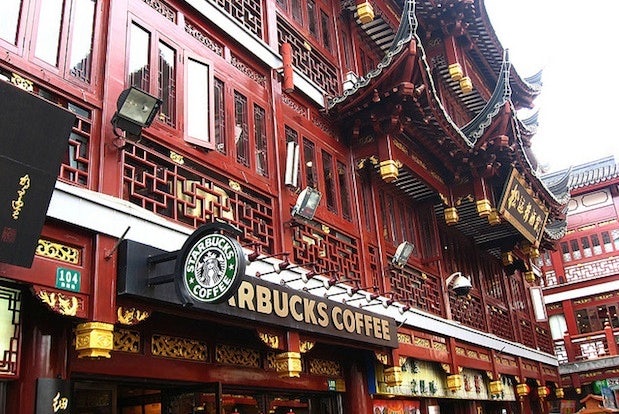
A Starbucks in Shanghai. (bitslice cipher/Flickr)
There has been a great deal of media attention on Starbucks in China over the past few weeks, stemming from a Wall Street Journal article comparing Starbucks' pricing in China and the United States and culminating in CCTV’s recent exposé of the American coffee company's China pricing.
Although price differences between China and the rest of the world are a major driver of consumer spending behavior, consumer perception and support for Starbucks has been remarkably resilient in the face of the recent media onslaught and the brand may actually benefit from CCTV’s free PR campaign. Why Starbucks has been able to avoid a consumer backlash for its China pricing provides three key lessons for luxury brands that are trying to engage with China’s increasingly global consumers:
Chinese consumers don’t like feeling ripped off#
Starbucks was a poorly chosen target for CCTV’s smear campaign, for the simple reason that its China pricing is more closely aligned with global levels than nearly every premium category. While a Starbucks coffee costs roughly 25 percent more in Shanghai than in New York, premium apparel, cosmetics, and handbags are commonly 40 to 100 percent more expensive in China than abroad. Chinese consumers are aware of these large price differences* and are (understandably) unwilling to purchase domestically when they have other options. That said, in my firm's recent study of Chinese tourists Europe, consumers rarely knew actual price differences between China and Europe and price comparisons between European countries were almost nonexistent. Not wanting to be ripped off* is the primary driver of overseas purchasing behavior, rather than an attempt to find the lowest price.
With that in mind, consumers accept in principal that foreign brands should cost slightly more in China than they do abroad, and are willing to pay a small premium for convenient access to these products. Starbucks’ 25 percent premium is within these tolerance levels. A nearly 100 percent premium for Kiehl’s skincare products is not, and drives consumers to purchase abroad or through a shopping agent. Luxury brands, take notice.
Consumers are willing to pay for experiences#
Starbucks is not about coffee. Starbucks is an experience—and this is even more so the case in China where the local Starbucks is a key destination for business meetings, study sessions and catching up with friends. Consumers don’t begrudge paying Starbucks’ prices because the value they receive (a few hours in a nice, quiet location, free Wi-Fi, and the prestige of a premium venue) goes far beyond the price of a coffee. This same logic applies to luxury brands. Luxury is a category driven by emotions, and brands can negate consumers’ feeling of being "ripped off" when paying the "China price" by creating unique experiences that add value beyond a simple transaction. Already, brands are being more innovative in engaging with their Chinese customers, and we expect to see more following in the footsteps of brands such as Hublot.
There are opportunities in non-transferrable categories#
If a consumer wants a cheaper Starbucks latte, they can’t order it online or have a friend bring it back from an overseas shopping trip. Likewise, there will always be luxury products or categories that are more protected than others from international pricing differentials. Domestic demand for luxury cars, despite being more than double the price in China than abroad, is not going anywhere since customers don’t have alternatives to paying the China. Demand for last-minute jewelry gifts is enduring, as any boyfriend or husband will know. Made-to-measure suits, with multiple fittings, face logistical challenges for targeting the Chinese traveler and will always be more convenient to purchase at home.
As easily transferrable purchases shift online and abroad, there are winners and losers in the domestic market at both the brand and the category level. To be maximize their success, luxury groups and brands should identify what categories are protected from this trend and optimize their portfolios and domestic presence accordingly.
*Adding insult to injury, consumers believe the bulk of the price difference goes to the government. Nobody likes taxes. On the bright side, brands are not necessarily the number one target for consumer wrath over the China Price.
James Button is a Senior Manager at SmithStreetSolutions
,#
a growth consultancy based in Shanghai, where he works with a number of premium and luxury brands on their China entry, growth, and e-commerce strategies. Follow James and SmithStreetSolutions on Twitter.